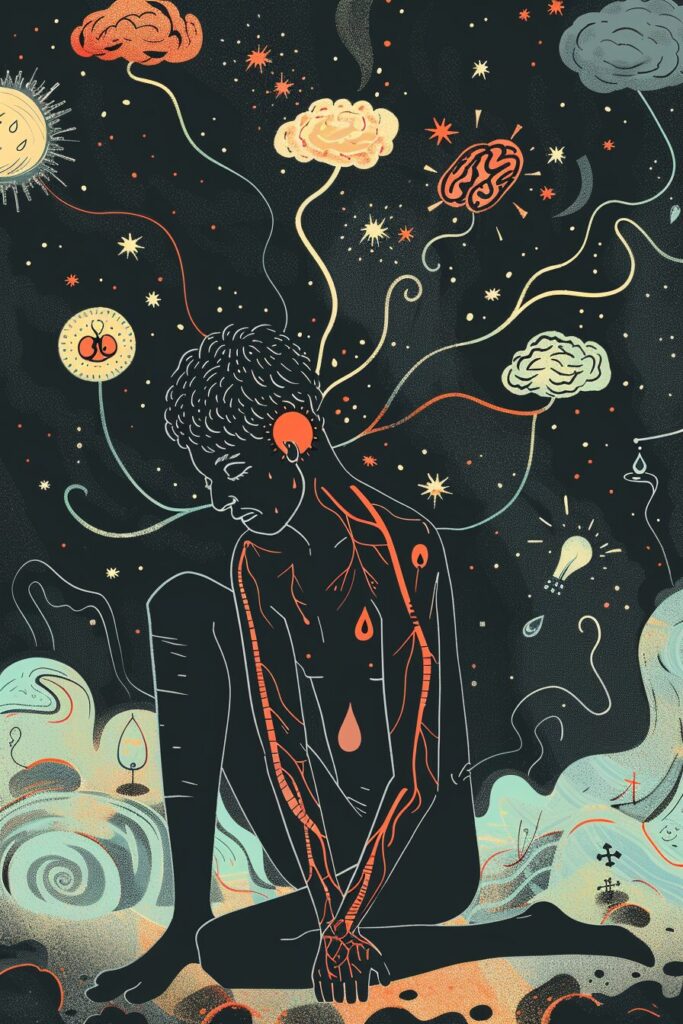29 Signs You’re Healing & Releasing Trauma

Healing from trauma can often feel like a turbulent journey. There are days when progress is evident, and other times when it feels as though you’ve taken a step backward.
The truth is, healing is not a straightforward path but rather a messy and often painful process.
In this article, we’ll explore what trauma is and identify 30 signs that indicate you’re healing and releasing trauma.
Understanding and healing from trauma is crucial for your overall well-being—mentally, emotionally, and physically.
Trauma impacts your perception of the world and the people around you, sometimes obscuring reality and fostering negativity.
This distortion, which I call “the dark lens,” skews your view of the world, leading to fear, prejudice, and limiting beliefs.
To clear this “dark lens” and adopt a more positive outlook, you must embark on the healing process.
Here are 30 signs that show you’re on the right path toward healing and releasing trauma.
1. Recognizing the Need for Healing

Realizing how much healing you need is a profound step in your trauma recovery.
This awareness signifies that you’re becoming more spiritually attuned and deeply understand the healing process.
It’s not about self-blame; it’s about recognizing how past traumas have shaped your behaviors.
You start to see that many of your actions are responses to these traumas and begin to crave freedom from these patterns. This realization is a vital first step toward true healing.
2. Identifying New Wounds

As you progress in your healing journey, you start to notice additional emotional wounds and outdated thinking patterns that need attention.
This heightened self-awareness comes from understanding how trauma impacts you.
Healing one aspect often uncovers others that need work. This process indicates growth, showing you are becoming more attuned to your emotional landscape.
With this awareness, you can address these wounds and move closer to a healthier state of being.
3. Seeing Family Trauma

Understanding trauma’s generational impact is a key sign of healing.
You start to see similar patterns of behavior and emotional responses in your parents, grandparents, and other relatives.
Recognizing that some trauma responses are inherited helps you understand they are not solely yours. This realization is crucial for breaking free from these inherited patterns.
Knowing your family’s trauma history empowers you to make conscious changes and stop these harmful cycles.
4. Spotting Your Toxic Patterns

Seeing your own toxic patterns is a significant sign of healing.
You begin to understand that many of your behaviors stem from survival mechanisms learned in childhood or from your parents.
When you reflect on major events in your life, you notice recurring themes and similar responses.
This awareness allows you to recognize and start changing these patterns, moving towards a healthier way of living.
5. Craving Healing

When you understand that your unhappiness and unfulfilled dreams stem from trauma responses, you begin to crave healing deeply.
You become eager to explore any method, philosophy, or practice that can help. Seeking out therapists, mentors, healers, and coaches becomes a priority.
Your focus shifts to healing, and even if progress feels slow, this craving is a sure sign that you are on the path to recovery.
6. Connecting Health to Emotions

As you heal from trauma, you start recognizing how your thoughts, emotions, and patterns influence your physical health.
It becomes clear that many health issues stem from unresolved mental or emotional imbalances.
This understanding helps you realize that feeling unwell is not random but often a result of internal disharmony.
You begin to see the connections between your negative emotions, harmful behaviors, and physical symptoms.
Acknowledging this link empowers you to change your thoughts, emotions, and behaviors, initiating a deeper, more comprehensive healing process.
7. Tuning into Your Body

Learning to listen to your body is a crucial aspect of healing from trauma. Feeling safe within your own body is foundational to recovery.
As you begin to feel more consistently safe and connected to your body, you know you’re making progress.
Trauma can make you feel disconnected or overly aware of your physical sensations, but healing brings balance.
Being mindful of your body’s signals—whether it’s tension, headaches, or gut feelings—helps you navigate life’s challenges more effectively.
By paying attention to these signals, you can make better choices about your environment, relationships, and overall well-being.
8. Embracing Responsibility

Taking responsibility for your life is a significant indicator of healing.
You start to understand that you have control over what you allow into your life and how you respond to situations.
This shift in perspective helps you move from feeling like a victim to recognizing your power in shaping your experiences.
By choosing which thoughts to focus on and managing your emotions more effectively, you regain control.
This newfound responsibility leads to better decisions in all areas of your life, allowing you to reclaim your power and create a life that aligns with your true self.
9. Changing Old Patterns

Breaking old, dysfunctional patterns is a clear sign of healing.
As you understand the impact of trauma, you begin making different choices and behaving in ways that reflect your healing progress.
Even small changes in behavior indicate that you are moving away from old, toxic patterns.
You might not eliminate all negative behaviors at once, but each positive change is a step forward.
Recognizing and celebrating these shifts, no matter how small, shows that you are actively working towards a healthier, more fulfilling life.
10. Improving Overall Well-Being

An improvement in your emotional, mental, and physical health is a significant sign that you are healing from trauma.
Even if progress is gradual, feeling better in any aspect of your life indicates that healing is taking place.
You will still have bad days, and negative emotions or thoughts might not disappear overnight, but noticing even slight improvements means you’re on the right path.
When you can honestly say that your overall state is better than it was before, it’s a clear sign that your efforts to heal from trauma are effective.
11. Prioritizing Inner Peace

A major sign of healing from trauma is when your primary focus shifts to achieving inner peace and overall wellness.
Previously, you might have been preoccupied with your career, relationships, appearance, or financial status.
However, as you heal, you realize that mental, emotional, and physical health are paramount.
You begin to choose people, situations, and environments that promote a sense of well-being and distance yourself from those that bring negativity.
At this advanced stage of healing, your inner peace remains largely undisturbed, as you have learned to let go of expectations and attachments that previously caused you distress.
12. Gaining Clarity on Your Journey

Understanding the purpose behind your struggles is a significant indicator of healing.
Where you once felt resentment towards life’s challenges, you now see them as part of a larger plan.
This newfound clarity brings acceptance and peace, helping you recognize the value of every experience, no matter how painful.
You understand that everyone’s life includes highs and lows and that these moments are essential for growth.
This broader perspective allows you to appreciate the journey, even if it includes hardships, as an integral part of life.
13. Embracing Forgiveness

Learning to forgive those who have hurt you, including yourself, is a crucial step in healing from trauma.
When you are still deeply wounded, it’s easy to fall into the victim mentality and blame others.
Healing, however, brings a sense of acceptance and the ability to see the higher purpose behind your experiences.
Forgiveness is about releasing blame and understanding that holding onto resentment only prolongs your suffering.
By forgiving, you free yourself from the negative emotions tied to past traumas, allowing for true emotional release and physical well-being.
14. Fully Experiencing Your Emotions

As you heal, you start to genuinely feel your emotions rather than suppressing them.
This process can be intense, with moments of crying, anger, or sadness, but it signifies that you are no longer avoiding your feelings.
Facing your emotions head-on, instead of detaching from them, is a healthy sign of progress.
It may feel overwhelming at times, but this emotional engagement is crucial for processing and releasing trauma, ultimately leading to deeper healing.
15. Feeling Physically Better

One of the most encouraging signs of trauma healing is the improvement in your physical health.
As you release emotional trauma, your immune system strengthens, and many physical symptoms such as headaches, muscle tension, and fatigue start to diminish.
This physical well-being reflects your overall progress, showing that healing is happening on multiple levels.
Feeling better physically indicates that you are not only addressing emotional wounds but also allowing your body to recover and thrive.
16. Enjoying Activities Again

A clear sign that you’re healing from trauma is regaining interest in activities you once enjoyed.
As you release trauma, you’ll notice a boost in energy and enthusiasm, making it easier to engage in self-care, complete daily tasks, and participate in social activities.
You might find yourself looking forward to work or socializing with friends again, activities you may have avoided while struggling with trauma.
This renewed interest and energy indicate that you’re moving towards a healthier, more balanced life.
17. Rediscovering Hobbies

Trauma often leads to the abandonment of hobbies and interests. As you heal, your passion for these activities tends to resurface.
You begin to enjoy your favorite pastimes again, whether it’s reading, painting, playing sports, or any other hobby that brings you joy.
This return to hobbies signifies that you are reclaiming parts of your life that were overshadowed by trauma, highlighting your journey towards recovery and self-renewal.
18. Increased Curiosity About Life

An essential sign of healing is a newfound curiosity about yourself and the world around you.
Healing from trauma fosters a sense of wonder and the desire to understand why things are the way they are.
This curiosity encourages you to ask questions and explore deeper meanings, rather than accepting things at face value.
By embracing curiosity, you become more open to examining challenging emotions and beliefs, allowing for greater self-awareness and integration of your experiences.
19. Consistent Sense of Self

A significant marker of healing is feeling like yourself, even when your moods, thoughts, and physical sensations fluctuate.
Many who have experienced trauma struggle with maintaining a stable sense of identity amidst changing internal states.
Healing helps you connect with your core self, recognizing what makes you uniquely you, regardless of emotional or physical changes.
This stability allows you to navigate life’s ups and downs with a stronger sense of who you are.
20. Balancing Complex Emotions

Being able to hold multiple, sometimes conflicting, emotions simultaneously is a vital aspect of trauma recovery.
You might feel love and anger towards a person simultaneously, and part of healing is acknowledging that these feelings can coexist.
This ability to embrace complex emotional experiences without feeling overwhelmed signifies growth and emotional maturity.
It shows that you are learning to accept and integrate different parts of your experiences, leading to a more nuanced and resilient self.
21. Understanding the Connection Between Past and Present

Healing from trauma involves recognizing how your past influences your present while distinguishing between the two.
Traumatized individuals often subconsciously recreate past patterns in current relationships, finding themselves in familiar yet harmful dynamics.
As you heal, these automatic reactions decrease, and you begin to identify these patterns more quickly.
This awareness allows you to say, “I know what this is” or “I know what’s happening now.”
While you may not immediately stop these reactions, becoming more self-aware helps you differentiate between past and present, reducing their impact on your current life.
22. Setting Healthy Boundaries

A sign of healing from trauma is becoming more confident in establishing and maintaining boundaries in relationships.
People with relational trauma often struggle with boundaries, either setting them too loosely or too rigidly.
Healing allows you to find a balanced approach, making it easier to say ‘no’ firmly and gracefully.
You no longer feel the need to overcompensate by cutting people off or being overly harsh.
Instead, you become more comfortable with what to say and do, ensuring that your boundaries protect your well-being without causing unnecessary conflict.
23. Facing Trauma Triggers

Another indicator of healing is the reduced need to avoid trauma triggers.
Avoidance can perpetuate anxiety, but exposure therapy helps minimize the fear response to these triggers.
Through trauma-focused therapy, you learn to engage with your trauma in different ways, making these triggers less activating over time.
As you become more capable of tolerating them, you incorporate these triggers into your daily life without fear.
This process helps break the cycle of avoidance, fostering a routine of healing where triggers lose their power over you.
24. Improved Muscle Relaxation

One of the clear signs of trauma healing is when your muscles start to feel more relaxed.
Trauma keeps the body in a state of constant alert, with tense muscles ready to respond to threats.
Healing helps your body recognize that it’s safe, activating the parasympathetic nervous system, which promotes relaxation.
As a result, you begin to experience less muscle tension and more physical calmness.
Techniques such as progressive muscle relaxation can further support this process, helping you feel more at ease and secure in your body.
25. Improved Breathing Patterns

Healing from trauma often brings noticeable changes in your breathing. Trauma triggers a state of constant alertness, causing rapid, shallow breathing.
As you heal, your brain recognizes that the threat has passed, allowing your breath to slow and deepen.
Practicing diaphragmatic breathing helps calm the nervous system, promoting a sense of safety and relaxation.
Incorporating regular breathwork into your routine can regulate emotions and provide a calming technique to manage stress and trauma triggers, fostering a greater sense of well-being.
26. Better Gut Health

Trauma can severely impact your digestive system, often leading to issues like irritable bowel syndrome, acid reflux, and other gastrointestinal problems.
During trauma, the body deprioritizes digestion to focus on immediate survival.
As you heal, your brain acknowledges the need for proper nutrition, reactivating and improving digestive functions.
This results in better gut health, reduced digestive issues, and an overall improvement in your physical well-being, highlighting the profound connection between mental and physical health.
27. Enhanced Sleep Quality

One of the signs of healing from trauma is improved sleep.
When your body is stuck in a state of high alert, falling and staying asleep becomes difficult due to anxiety and nervous system arousal.
As you release trauma and your body feels safe again, your brain allows you to relax and drift into restful sleep.
Better sleep not only indicates recovery but also contributes to overall health, helping you feel more refreshed and energized during the day.
28. Boosted Immune System

Healing from trauma can lead to better immune functioning.
Trauma diverts the body’s resources away from non-essential processes like immunity, leading to increased susceptibility to illnesses and chronic conditions.
As you resolve the effects of trauma, your body redirects energy back to the immune system, enhancing its ability to fight off infections and maintain overall health.
This improvement underscores the interconnectedness of mental health and physical resilience.
29. Increased Sense of Purpose + Curiosity

A notable sign of trauma recovery is the emergence of a stronger sense of purpose.
As you heal, you start to feel more connected to your goals and values, finding meaning in your experiences.
This renewed sense of purpose drives you to pursue passions and engage in activities that align with your true self.
Feeling a greater sense of purpose enriches your life and motivates you to continue your healing journey.
As you heal and feel safer, your natural curiosity and desire to engage with life are restored.
This renewed interest not only indicates healing but also enriches your life, allowing you to explore new experiences and embrace personal growth.
Final Thoughts
Healing from trauma is a challenging but profoundly rewarding journey.
It’s important to remember that healing is not a linear process, and setbacks are part of the path to recovery.
By recognizing the signs of healing—whether it’s reconnecting with your hobbies, setting healthy boundaries, or experiencing better physical health—you can celebrate the progress you’ve made.
Embrace the process with patience and self-compassion, knowing that each step forward, no matter how small, is a victory.
You are resilient, and with continued effort and support, you can move towards a life filled with peace, joy, and fulfillment.
Keep believing in your capacity to heal, and remember that every effort you make is bringing you closer to a brighter, healthier future.
FAQs
What’s The Hardest Part Of Trauma Healing?
Determining the hardest part of healing varies depending on how trauma has affected you.
For many, the biggest challenge is learning to trust themselves again, especially their own sense of reality.
Gaslighting can erode this trust, making it difficult to rely on your intuition, which is vital for feeling safe.
Others struggle with self-regulation, managing thoughts, emotions, and sensations.
This might involve overcoming dissociation and finding ways to reconnect with yourself.
Additionally, establishing and maintaining boundaries in relationships can be tough, as trauma often disrupts your ability to trust others.
If you’re taking steps to seek help, you’ve already begun one of the most challenging parts of healing—starting the journey.
How Long Does Healing Take?
Many people want to know how long it takes to heal from trauma, but there’s no set timeline.
Healing is unique to each individual and depends on various factors.
The key is to focus on the process rather than the duration. Finding a skilled therapist you trust and staying open to the therapeutic process is crucial.
Make healthy choices and seek supportive relationships to aid your recovery. Remember, healing is a journey, and the time it takes varies for everyone.
Is Trauma Healing Difficult?
Healing and releasing trauma can be a challenging and painful process.
Regaining a sense of safety and aliveness can feel uncomfortable, like numb limbs thawing.
The process is even more complicated if you’re also dealing with addiction or other mental health issues.
Self-gaslighting, where you doubt your own reality due to past manipulation, can add to the difficulty.
Despite these challenges, working through trauma is possible and necessary for recovery.
How to Start Releasing Trauma?
Starting your trauma-healing journey involves seeking support from professionals and peers.
Look for mental health professionals trained in trauma-informed therapy to avoid treatments that might cause further harm.
Different types of trauma therapy can help process and integrate traumatic memories, making them less intrusive in daily life.
Here are some effective therapies:
EMDR: This therapy uses bilateral brain stimulation to process traumatic events.
Trauma-focused CBT: Aimed at children and adolescents, this therapy helps modify thoughts and behaviors related to trauma.
Internal Family Systems (IFS): This therapy helps you reconnect with your essential self by managing parts of you affected by trauma.
Play Therapy: Useful for children and adults, this therapy processes trauma through play and art.
Somatic Experiencing (SE): This therapy targets the body’s experience of trauma, improving the mind-body connection to release stored trauma.
